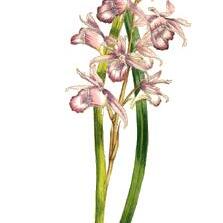Terrestrial or rarely epiphytic herbs, with crowded internodes at base sometimes swelling to form a pseudobulb; roots fibrous. Leaves several, either arising from pseudobulb or spaced along an erect stem; petioles long; lamina elliptic to lanceolate-oblong, acute or acuminate, plicate. Flower-scape basal or lateral, usually erect. Inflorescence racemose, terminal, 1-to few-flowered. Flowers usually large, often conspicuously coloured. Sepals free, subequal, spreading; petals similar, narrower. Lip erect, concave or cucullate, entire or ± 3-lobed, side lobes embracing column, base often adnate to column, spurred or saccate, longitudinally ridged on upper surface. Column elongate, clavate, 2-angled at apex, arms absent, foot sometimes present; anther operculate, incumbent, distinctly 2-celled, often hairy; pollinia 8 in 2 groups of 4, obovate-oblong, laterally compressed, caudiculate; viscidium absent; stigma near apex of column, occasionally with small appendages; rostellum present or absent. Capsule ellipsoid.
Evergreen, clumping, terrestrial orchids with thick, coarse roots. Clumps consisting of either large, crowded pseudobulbs or elongated stems. Leaves several per shoot, petiolate, large, thin-textured, plicate. Inflorescences tall, arising from axils of lower leaves or bracts, multiflowered. Peduncle usually longer than rachis, fibrous, with stem-encircling bracts. Flowers moderately large, often colourful. Sepals and petals free, of similar shape and size. Labellum base attached to anterior base of column. Labellum lamina unlobed or 3-lobed , usually tubular towards the base where it forms a pouch or short basal spur; lateral lobes usually incurved around column; midlobe spreading. Column thick, hairy, without basal foot.
Sepals and petals free, subequal; lip erect, entire or 3-lobed, spurred or saccate, with longitudinal ridges on the upper surface.
Terrestrial (rarely epiphytic) herb with fibrous roots, sometimes with pseudobulbs.
Leaves arising from a pseudobulb or spaced along the stem, petiolate, plicate.
Column long, clavate; anther operculate, incumbent, 2-celled.
Pollinia 8 in 2 groups of 4 with caudicles but no viscidia.
Inflorescence 1-to few-flowered.
Stigma near apex of column.

